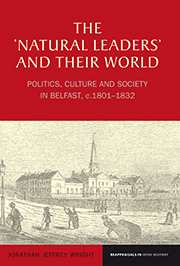Book contents
- Frontmatter
- Contents
- Acknowledgements
- Abbreviations
- Introduction
- 1 Will Tennent's band of ‘bastards and rebels’: the Tennent family in its contexts
- 2 The ‘natural leaders’, part one: politics and personalities in Belfast, c.1801–1820
- 3 The ‘natural leaders’, part two: Belfast, Europe and the age of reform
- 4 ‘The manhood of the mind’: classicism, romanticism and the politics of culture
- 5 ‘Thank-offerings to the God of providence’: philanthropy, evangelicalism and social change
- Conclusion
- Appendices
- Select Bibliography
- Index
1 - Will Tennent's band of ‘bastards and rebels’: the Tennent family in its contexts
- Frontmatter
- Contents
- Acknowledgements
- Abbreviations
- Introduction
- 1 Will Tennent's band of ‘bastards and rebels’: the Tennent family in its contexts
- 2 The ‘natural leaders’, part one: politics and personalities in Belfast, c.1801–1820
- 3 The ‘natural leaders’, part two: Belfast, Europe and the age of reform
- 4 ‘The manhood of the mind’: classicism, romanticism and the politics of culture
- 5 ‘Thank-offerings to the God of providence’: philanthropy, evangelicalism and social change
- Conclusion
- Appendices
- Select Bibliography
- Index
Summary
Who were the Tennents? Writing in June 1857, Robert James Tennent recounted some of the claims that had been made regarding his family's history. The name Tennent, he noted, was believed to have been ‘derived from the royally allied D'Annands of the Scottish south west’, and numbered among his ancestors were individuals who ‘filled the highest municipal dignities in the Scottish Metropolis’, ‘married sisters of archbishops and kinswomen of lords’, ‘sat in an English parliament so long ago as the middle of the 16th century’ and ‘fought for Mary at Layside’. Later, another had ‘followed the court of James to England’, while ‘the Scottish branch took a full share of persecution and worldly ruin with the Covenanters’. In their own mythology the Tennents were thus a family of long and distinguished antecedents, but to place them in their more immediate context we must leave aside these intriguing tales of barons, bishops and covenanters and begin instead with a more humble figure – the Revd John Tennent.
‘Blest Tenant … faithful servant of the Lord’
Save for the facts that he was born to William Tennent, a farmer, of Mid Cather, Midlothianshire, and his wife, Margaret Tennent, née Dunne, in May 1727; that he preached first in May 1749; and that he was ordained as minister of the joint County Antrim and County Londonderry charges of Ballyrashane, Derrykeighan and Roseyards on 16 May 1751, little is known of the Revd John Tennent's early life.
- Type
- Chapter
- Information
- The 'Natural Leaders' and their WorldPolitics, Culture and Society in Belfast, c. 1801–1832, pp. 13 - 48Publisher: Liverpool University PressPrint publication year: 2013

